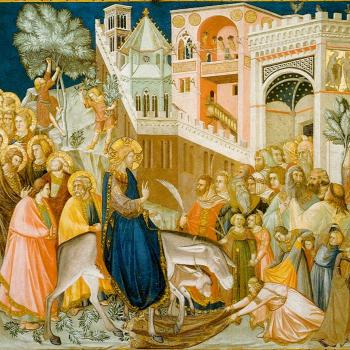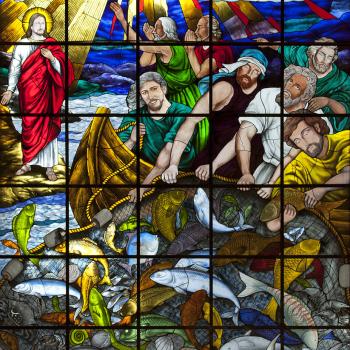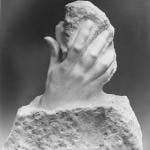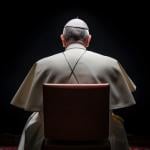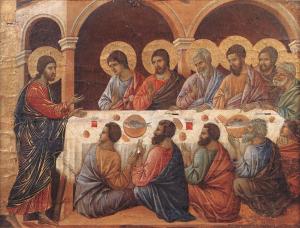
Anglican theologian Andrew Linzey, following a significant tradition of Christian exegesis, explained that humanity originally was meant to be vegetarian. It was, indeed, a kind of divine command. “Genesis 1 clearly depicts vegetarianism as divine command.”[1] If the original intention for humanity, as shown in the beginning of Genesis, was to have a meat-free diet, and Jesus is said to restore humanity within himself to a pristine, pre-fallen state, some people might want to ask what are we to make of Jesus and his eating habits? Was he a vegetarian? In many ways, that would be what we should expect, but then Scripture seems to suggest, after the resurrection, he ate some broiled fish: “They gave him a piece of broiled fish, and he took it and ate before them” (Lk. 24:42-43 RSV). What are we to make of that incident? Does it suggest that Jesus might, after all, had no problems eating and consuming meat, and did not, then, return humanity to its earlier state?
There are many ways to answer this question. One way is to consider Jesus a vegetarian, who, nonetheless would take whatever food was given to him at eat of it so as not to insult the giver of the gift. This could parallel God accepting animal sacrifices while not really wanting or needing them: “Do I eat the flesh of bulls, or drink the blood of goats? Offer to God a sacrifice of thanksgiving, and pay your vows to the Most High” (Ps. 50:13-14 RSV). Humanity had become accustomed to offering sacrifices to God, including human sacrifices; God’s relationship with Israel seems to suggest a progressive movement away from such sacrifices. Abraham was stopped from sacrificing his son, Isaac, putting an end to human sacrifice; Moses established regulations for animal sacrifices, putting a limit to how they were to be done. Then the prophets had God show forth a disinterest in them, pointing out that they were accepted but not needed or desired by God:
“What to me is the multitude of your sacrifices? says the LORD; I have had enough of burnt offerings of rams and the fat of fed beasts; I do not delight in the blood of bulls, or of lambs, or of he-goats. When you come to appear before me, who requires of you this trampling of my courts? Bring no more vain offerings; incense is an abomination to me. New moon and sabbath and the calling of assemblies — I cannot endure iniquity and solemn assembly (Isa: 1:11-13 RSV1).
What God desired is a pure heart, a circumcision of the heart (cf. Jer. 4:4), that is, love and the devotion which comes out of such love. God worked with humanity. He came to them where we were at and slowly directed us away from our cultural and philosophical understandings to something better. Humanity once thought sacrifices were needed. God showed that though he accepted, they were not in his plan for humanity. He accepted them out of the devotion which was shown to him, but he was working to move humanity beyond such primitive thinking, so that they could and would expect a different, and indeed, better relationship with him.
Similar to the way God took and accepted the offerings given to him with a pure heart, it could be said that the God-man, Jesus likewise continued interacting with humanity in a similar fashion. In and through his humanity he accepted the fish which was given to him because what was given was given out of love and devotion to him. He did not need it. And, to be sure, after his ascension, he would not be receiving such food, similar to the way the sacrifices stopped once the temple was no more.
Nonetheless, this is not the only way to read what happened after the resurrection. There are scholars who think the incident did not happen as stated: they think it was a later construction used to demonstrate that Jesus was truly resurrected, that his disciples did not encounter a ghost. They think the text was written as a kind of apology for the resurrection; Gerald O’Collins in his article, “Did Jesus Eat the Fish (Luke 24:42-43)”? examined the evidence various scriptural exegetes gave to the passage, explaining why they think it did not need to be seen as literal history. O’Collins, likewise, thought that Luke himself gaves hints in the book of Acts, in Acts 1:4 and Acts 10:41 to suggest that Jesus himself did not really eat with the disciples, but rather he was there with them when they ate, being a “corrective self-commentary” from Luke himself.[2] Why did such a corrective need to be given? Because there are questions concerning the resurrected body itself: Paul suggests that the body, when transformed into its immortal state, will no longer need food and have no more stomach for food:
“Food is meant for the stomach and the stomach for food” — and God will destroy both one and the other. The body is not meant for immorality, but for the Lord, and the Lord for the body. 14 And God raised the Lord and will also raise us up by his power (1Cor. 6:13-14 RSV).
Many church fathers, to be sure, suggest that the answer here is that Christ did not need to eat, but he could if he wanted to, and did, to show that he was indeed risen from the dead and not just some ghost.
The question remains, what are we to think about Luke’s portrayal when we read Paul? Does it not suggest some sort of internal contradiction within Scripture? But that is only the case if the event recorded in the Gospel of Luke was intended to be taken as literal history. We are used to thinking it as such, but to be sure, it is not always clear that this was the intention of Luke or the compliers of Scripture. It is also within tradition to interpret the text as allegory. The text was written to make one, if not many, theological points, and we are missing those points if we try to read it as positive history. Of course, one of those points is that Jesus rose from the dead and became something different as the raising from the dead transformed him and his body into a new spiritualized state. But the other theological point can be the various ways the broiled fish could be interpreted; St. Anthony of Padua, taking a tradition which came long before him, explained how Jesus, accepting the fish, represented his acceptance of the passion which he had gone through:
The ‘broiled fish’ is the Redeemer who suffered, who was caught in the waters of the human race by the hook of death, and ‘broiled’ at the time of his Passion; and he, too, is the honeycomb for us in today’s Resurrection. The honeycomb is in the wax, as the divinity is in the humanity. In this eating it is signified that he takes them, in his body, to eternal rest, who, when they suffer trials for God’s sake, do not depart from the joy of eternal sweetness. Those who are ‘broiled’ here, will there be satisfied with sweetness. [3]
It is also possible, following and developing upon what St. Anthony said, to consider the fish to represent humanity (and the whole of creation) which was be taken up by Christ. Peter and Andrew were called to become the fisher of men: fish, then, can serve as a symbol for those who have been converted and handed over to Christ. The fish, after all, was the symbol early Christians used to represent themselves as a sign of their faith. There could, therefore, be a symbolic meaning to the text itself, where the early readers understood themselves to be the broiled fish given over to Christ, who then willingly takes them into himself and renders them to eternal rest in him.
For many, any answer which does not accept the event portrayed as having some sort of historical accuracy is not going to satisfy. We have become too accustomed to thinking about the events of Jesus’ life and resurrection in historical terms. We have become historized as a people. And so, though the possibility that the text is not historically accurate is a possible one, it can also be seen as a rather easy way out of the question at hand. What are we to say to those who want to view the text historically? Jesus, they believe, even if he did not need to eat, could and did eat the fish once it was given to him. But as said above, if we want to view Jesus as fulfilling pre-fallen humanity, with its lack of meat-eating, it is possible to take this story as representing of Jesus’ solidarity with humanity, even after the resurrection, so he is willing to take what is given to him and consume it in a sign of accepting the hospitality given to him. Many vegetarians do the same thing today: they personally avoid meat-eating, but if they found themselves in a situation which required it, they could accept and eat meat given to them so as not to risk insulting their benefactor (think about a hiker being welcomed by indigenous tribes in South America: by accepting what is given, the hiker would form a bond of solidarity with the people, but if they should deny it because it is meat, the insult might be the last thing they ever do). This was, moreover, the way St. Francis of Assisi is said to have lived: personally, he avoided meat, but he would not deny it when given to him.
But what, then, are we to think of the fish? Does this not suggest that Jesus, in his care for humanity, had less concern for the rest of creation? Certainly, it is possible to read the text in this way, and many do. But is this the only way we need to consider the tale? Absolutely not. As Gerald O’Collins explained in his article, there is something eucharistic in the post-resurrection tale. If we read it with a eucharistic understanding of food, we might see something special was going on in relation to Jesus and the fish, something the disciples might not know or recognize at the time, but something which we can realize after further contemplation. In the eucharist, we receive Jesus into us, and in the process, we are said to be assumed by Jesus, being made a part of his body and given life because we share in the life of his own body. What if there is some eucharistic assumption into Jesus given to the fish itself, that is, though it was cooked and fed to Jesus, Jesus nonetheless took it into himself and rendered unto it new life, transforming it as he transforms all things into himself? Does this not also connect with what St. Anthony of Padua suggested, taking It further by understanding what is symbolically done to us is also done with the rest of creation as well? This understanding would be similar to a kind of sentiment which evolved in Jewish mysticism, one in which eating is said to release “holy sparks of life” contained in the food, rendering it back to God.[4] While the theory offered by the Kabbalah, which includes the notion of freeing reincarnated souls, might not be exactly one and the same with the Christian tradition and belief, it nonetheless might hint at what is going on here in that the life and soul of the fish itself could be said to be freed by Jesus taking it and accepting it into his body. Of course, this would only be realized in the extraordinary cases of Jesus himself, and not necessarily in us, which is why we should not consider using this as an excuse to justify any and all kind of eating, especially if we want to vouchsafe the notion that the original expectation for humanity was a vegetarian lifestyle.
It is best to be cautious when we try to interpret Scripture. Obviously, as scholars know, it was not meant to be taken simply as is; it was always understood to be filled with symbols and meanings which were spread through oral tradition as well as realized through the guidance of the Holy Spirit. When we have theological concerns which develop when various parts of Scripture seem to contradict itself, we must be cautious and not assume a simple reading of the text is justified. We might raise questions and not know the answers; if we suggest answers, we must accept their speculative status until they are tested and verified as being acceptable. This is what we must do when considering the question of whether or not Jesus actually ate fish, and if he did so, what it means that he did so. Scripture gives us reasons to question the event as being literal history with Paul’s discussion of the resurrected Jesus seemingly showing his new body would be one which would not and could not eat. Likewise, the original, pristine form of humanity, as represented in Genesis, did not eat meat: it was only seen as given over to humanity as permission after the Noahic flood.[5] This was after humanity had further moved away from its historical holiness and it could be said meat eating itself became necessary for survival: so long as it is necessary, it is justifiable even if not preferable. But with Jesus, the restoration of what was lost would seem to indicate a return to the original intention for humanity which would include a vegetarian diet. Except for the eating of fish, there is no text which specifically indicates Jesus himself ate meat (though there is the presumption he did at the Passover, and possibly when he was a guest at someone else’s home). If he ate meat, it would likely be in the same spirit as God accepting animal sacrifices: not as a preference, but rather as an acceptance of his historical context and the people around him.[6] But then, if he did, we might want to consider what he renders to the animal which was eaten. All those who become a part of Christ put on Christ and partake of Christ and his resurrection. By being consumed by Christ, they are rendered a part of him, and share a eucharistic communion with him; once dead, they come alive in Christ just as Christians do with their communion. Thus, though there are questions, serious questions to consider, it is possible to view Christ as eating flesh, if it happened, does not neglect or overturn the normal ethical evaluation given to meat eating by vegetarians, nor the Christian vegetarian understanding that the original and most virtuous approach to food is to follow the injunctions found in the beginning of Genesis. There are ways for Christian vegetarians to read the text which do not contradict the basics of Christian theology nor deny that there is authentic meaning to be found in the text of Luke 24:42-3. More work, more study, more contemplation might need to be done to determine which of them, if any, is the most acceptable answer, but the point is, answers can be had and Christian vegetarians can remain assured that the general principles they hold do not have to be seen as being contradicted by Jesus himself.
[1] Andrew Linzey, Animal Theology (Chicago: University of Chicago Press, 1995), 125.
[2] Gerald O’Collins, “Did Jesus Eat the Fish (Luke 24:42-43)”? in Gregorianum Vol. 69, No. 1 (1988): 72.
[3] St. Anthony of Padua, Sermons for Sundays and Festivals. Volume r. trans. Paul Spilsbury (Padua: Edizioni Messaggero Padova, 2010),193.
[4] See Alan Unterman, trans. and ed., The Kabbalistic Tradition (London: Penguin Books, 2008), 210-211.
[5] St. Jerome commented upon this, saying, “He raises the objection that when God gave his second blessing, permission was granted to eat flesh, which had not in the first benediction been allowed. He should know that just as divorce according to the Saviour’s word was not permitted from the beginning, but on account of the hardness of our heart was a concession of Moses to the human race, so too the eating of flesh was unknown until the deluge. But after the deluge, like the quails given in the desert to the murmuring people, the poison of flesh-meat was offered to our teeth. The Apostle writing to the Ephesians teaches that God had purposed in the fullness of time to sum up and renew in Christ Jesus all things which are in heaven and in earth. Whence also the Saviour himself in the Revelation of John says, “I am Alpha and Omega, the beginning and the ending.” At the beginning of the human race we neither ate flesh, nor gave bills of divorce, nor suffered circumcision for a sign. Thus we reached the deluge. But after the deluge, together with the giving of the law which no one could fulfil, flesh was given for food, and divorce was allowed to hard-hearted men, and the knife of circumcision was applied, as though the hand of God had fashioned us with something superfluous. But once Christ has come in the end of time, and Omega passed into Alpha and turned the end into the beginning, we are no longer allowed divorce, nor are we circumcised, nor do we eat flesh, for the Apostle says, “It is good not to eat flesh, nor to drink wine.” For wine as well as flesh was consecrated after the deluge,” St. Jerome, “Against Jovinianus” in NPNF2(6):360.
[6] Andrew Linzey in his analysis of Christ’s eating suggests that he accepted the limitations placed upon him in relation to his historical context. He ate to be human, eating what was available to him. “The fourth answer is that sometimes it can be justified to kill fish for food in situations of necessity. Such a situation, we may assume, was present in first-century Palestine where geographical factors alone seem to suggest a scarcity of protein. Such a view would on the whole be more consistent with the biblical perspective that we may kill only in circumstances of real need,” Andrew Linzey, Animal Theology, 134.
Stay in touch! Like A Little Bit of Nothing on Facebook.
If you have liked what you read, please consider sharing it with your friends and family!










